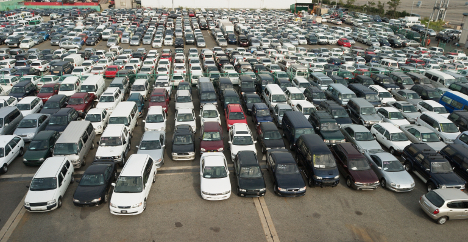NADA Used Car Guide today announced the launch of NADA Values Online.
The NADA Values Online product, formerly known as NADA online, offers additional features and as well as new pricing guidance.
"The replacement of NADA Online with the NADA Values Online product means our business-to-business customers will have powerful new features that make the vehicle valuation process even more insightful and efficient," said Mike Stanton, vice president and chief operating officer of NADA Used Car Guide.
The addition of new-vehicle values, "…completes the valuation picture," said Stanton.
The tool provides a full suite of pricing guidance, including information on new-vehicle and auction values (low, average, high), trade-in (rough, average, clean), clean loan and clean retail values for used passenger cars and light-duty trucks.
Management at NADA UCG explained that the new-vehicle values pricing guidance is presented as an “insightful value estimation range.” And the range of low, average and high values is based on actual market transactions and market influences.
“New vehicle values are provided as a range because the aforementioned factors cause price variations in the new vehicle market,” NADA UCG shared.
NADA Values online users will be privy to the following:
- New-vehicle values for new vehicle pricing guidance
- Inventory valuation for saving and easily updating vehicle valuations
- Vehicle valuation trends for quick insight into wholesale and retail transactions
- Custom reporting that lets you select the data that best fits the deal
- Typically equipped MSRP for practical value comparisons
- A more intuitive design that displays vehicle info and photos clearly and simply
See here to check out the new tool.
At the close of the third quarter, our nation’s seven publicly traded dealer groups collectively averaged their 25th consecutive quarter of same-store used unit sales increases.
Cox Automotive’s chief economist Tom Webb, speaking during the Manheim Index Quarterly Conference Call on Friday, says a 26th is probable, but will be a challenge to achieve.
“Slide 14 shows the seven publicly trade dealership groups and it shows that they have had 25 consecutive quarters of same-store growth in used-units retailed,” Webb said, referring to slides accompanying his presentation. “Achieving the 26th quarter will be a little bit difficult because CarMax has already reported a 0.8-percent decline in their quarter, which ends in November.
“But I still think the 26th quarter will be achieved because CarMax was more focused on supporting gross than I believe that the others will be. Which, obviously, writes in the equation, that by extension, I expect the downward sloping lines in Slide 15 will also continue.”
And the latter slide, as you probably inferred, references the used-vehicle retail gross margin for the same publicly traded dealer groups. The gross margins for used sales for the public groups is currently trending to its lowest percentage in several years — a trend Webb says has two faces.
“Now, there are two ways of looking at that gross margin trend. One could just say it’s plain ugly, and it’s dangerous,” he said. “Or, you can argue that it’s just simply the case of a competitive industry passing on its efficiency savings to the consumer. Obviously the truth lies somewhere between the two.
“But more importantly, from my perspective, I do not believe that grosses should, and hopefully they won’t, go much lower. So that means don’t look for operating efficiencies at the retail level to continue to bail out the commercial consignors. The dealers have done more than their part,” Webb said.
He says dealership proficiencies have helped that margin decline due to the lowered costs of operation that result from such efficiencies.
“A lot of that reduction in gross, I wouldn’t say was ‘willingly’ given away, but because there were tremendous increases in operation efficiencies, other dealers were able to give it away,” Webb said. “The ability to keep achieving those operating efficiencies I think are a little bit limited going forward. And certainly the benefit of exceptional growth in the throughput has probably slowed it a little bit, too.”
For more takes on Webb’s analysis, including the used-car market’s current stretch of wholesale price stability, click here.
The past four years have been the “longest stretch of wholesale price stability” in the two-decade history of the Manheim Used Vehicle Value Index, Cox Automotive chief economist Tom Webb said in his quarterly conference call Friday morning.
“And that’s a good thing, because precious few in this industry benefit from volatility in used-vehicle pricing,” Webb said.
In fact, each year beginning with 2012 showed wholesale price changes of less than 2 percent (positive or negative), Webb pointed out.
The Manheim index was up 1.2 percent on annual average basis for full-year 2015, Webb said, following a 1.5-percent gain in 2014, a 1.8-percent decline in 2013 and a 1.0-percent dip in 2012.
Macro-economic and industry conditions have played a role in that stability, but it’s important to note the “better, efficient remarketing practices, which have enabled our commercial consignors to anticipate, respond to and thus minimize impending swings in wholesale pricing,” Webb said.
But how long will this stability last?
“I think this year is setting up well. Generally speaking, you’re going to get that volatility more along the lines of changes in the macro-economic conditions or the retail environment, most notably credit. It would appear to me that 2016 still looks favorable from that standpoint,” Webb said. “Getting out beyond that, it would be logical to assume that we get a little more volatility back into the market.”
Prices in the used-car market remain at a high level. The index (on a mix-, mileage- and seasonally adjusted basis) reached 125.7 in December, which was up 1.5 percent year-over-year. Webb points out that this marks the sixth time in seven months the index has increased, pushing it to its strongest mark nearly four-and-a-half years.
But consider this, he said. There is a slide in his quarterly presentation (page 6 here) using Manheim Consulting/Bureau of Labor Statistics that shows how wholesale prices compare to the new-vehicle consumer price index.
“The takeaway here is that, yes, used-vehicle pricing is strong, but it is not outside of historic norms, given structural norms in the industry,” Webb said.
Also, strong used prices aren't outside or immune to possibly challenging conditions.
One of the more pressing issues the wholesale market will continue to face this year and beyond is the off-lease volume.
After reaching about 2.5 million in 2015, Manheim Consulting data estimates there will be more than 3 million off-lease units to hit the wholesale market this year, with more than 3.5 million in 2017, before approaching 4 million in 2018.
“I was the optimist last year with respect to wholesale pricing, and I think my 2016 outlook is also better than most,” Webb said. “But let’s not kid ourselves: 4 million in ’18 will be a challenge, even under the most optimistic economic scenarios.”
Used prices were falling in December, and with an influx of off-lease vehicles expected to hit the lanes this year, declines as 2015 wrapped up were just the beginning.
And with new auto sales reaching record levels for 2015 — almost 17.5 million — it seems growing used supply with continue to spur depreciation in the coming years.
According to Black Book data, trucks finished the year with a total depreciation rate of 9.2 percent, ending the year with an average price of $20,543.
Cars dropped by a significantly more dramatic 18.2 percent to end 2015 with an average price of $14,196.
Truck sales soared in 2015 amid unusually low gas prices, and demand served to strengthen prices in the auction lanes.
With the increase in overall supply expected to start impacting the market this year, Black Book predicts 2016 deprecation to come in at close to 14 percent.
Prices were still on the way down in December, as well.
According to Black Book, the average price of a used vehicle for model years 2010-2014 fell by 1.8 percent in December.
Cars took a bigger 2-percent hit, while truck prices fell by 1.7 percent.
“Entering 2016, a record year for car sales totaling more than 17 million vehicles, the decrease in used car prices that we are seeing are showing a still-stable used-vehicle market,” said Anil Goyal, vice president of automotive valuation and analytics for Black Book. “One thing to watch, however, is the discrepancy in depreciation patterns between car and truck segments, as this gap is widening.”
Subcompact luxury CUVs took the biggest depreciation hit out of all the segments. Prices for this segment dropped 6 percent in December. After the drop, the segment started 2016 with an average price of $18,039, which is down 20 percent year-over-year.
Black Book pointed out three other segments saw monthly depreciation rates of 3.2 percent or more.
The subcompact luxury CUVs (down by 6 percent), sub-compact crossovers (down by 3.3 percent) and the compact vans (down 5.3 percent) all saw larger-than-average price drops.
Like was seen much of the year, full-size pickups once again posted the lowest depreciation rate in December, with rates only dropping by 0.5 percent. Vehicles in this segment started the year out with an average price of $23,379, which is down 1.7 percent year-over-year.
During the last week of December, auction prices were on the way down, but activity in the lanes held up well amidst the holidays.
According to the latest Black Book Market Insights report, although all segments depreciated as 2015 came to a close, Black Book editors said auction personnel noticed overall prices stayed relatively strong throughout the holiday season, perhaps boding well for a strong start to the new year as we head into tax season.
“Overall, auction activity seems to have held up well this week considering the holidays. Maybe this will lead to a strong start for the New Year,” said Anil Goyal, vice president of automotive valuation and analytics.
This sentiment echoed throughout the lanes, as Black Book editors overheard an attendee from Alabama say, “Considering the holidays, it was a very good sales this week. Many more sales and buyers than I expected.”
Another auction attendee from Tennessee said, “Strong prices here today with a lot sold.”
According to Black Book data, car values fell by 0.33 percent or $40 last week, while truck values dropped by 0.36 percent or $62.
Last week, all the car segments Black Book tracks had higher week-over-week depreciation rates, except for the prestige luxury segment, which remained stable.
The near-luxury car segment saw the largest depreciation among the cars, with rates dropping by $113 or 0.63 percent. The entry-level cars continued to experience larger-than-average declines, with prices dropping by 0.49 percent or $32 last week. But the compact car segment, which had seen rates drop significantly over the course of 2015, only saw prices fall by 0.09 percent or $8 to wrap up the year.
Interestingly, Black Book also pointed out the luxury level car segment, which saw prices drop by 0.37 percent or $82 last week, was the only segment to see prices drop during each week of 2015.
Among the trucks, which saw similar depreciation rates last week, the midsize CUV and mini cargo van segments saw the largest depreciation, with rates dropping by 0.75 percent and 0.84 percent, respectively.
Compact SUV prices held steady last week, and the full-size passenger vans only dropped by 0.01 percent or $2. Other strong performers included the full-size cargo van segment, with a drop of 0.05 percent or $7, and the minivan passenger segment, with prices falling by just 0.13 percent or $18.
Though used-vehicle supply growth is expected to lead to a softening of residual values in the coming years, pre-owned prices were still on the way up as 2015 came to a close.
According to the latest RVI Risk Outlook newsletter, used-vehicle prices, after being adjusted for MSRP, showed an increase of 1.9 percent in November from the prior month.
That said, prices were still down from 2014 highs. November used prices represented a year-over-year decline of 1.6 percent.
Almost every segment RVI tracks saw prices increased during November. But on a year-over-year basis, the larger, more expensive vehicles have performed better, RVI analysts point out, while small economical vehicles have lost value in a market where oil prices continue to drop.
For example, residual values in the subcompact segment were down by 9.5 percent year-over-year in November. In comparison, segments like the small SUV segment are seeing prices hold strong, with prices up 0.3 percent in November. According to the report, low gas prices and a low supply of small SUVs have helped keep values strong.
“While the supply of small SUVs has remained low over the past several years, this is expected to change dramatically starting in 2017,” the report stated, with prices expected to drop for the segment by 5.7 percent by 2018.
And the small SUV segment won’t be the only vehicle category feeling the impact of expanding supply.
In fact, RVI analysts expect used prices to fall by 4.9 percent from current levels by 2018. Part of this expected increase is due in part to an expected influx of off-lease vehicles entering the used market.
And leasing penetration continues to soar. During the third quarter of 2015, lease penetration was at 22.4 percent, up from 20.7 percent in Q2 and 19.9 percent in Q3 of 2014. And through the third quarter of 2015, the lease penetration rate for the year sat at 21 percent of total new vehicles sales. RVI analysts pointed out lease penetration has not been this high since the early 2,000s. In other words — get ready for some serious expansion in used supply in the coming years.
“A growing supply of used vehicles will lead to a softening of residual values. RVI forecasts an increase in leasing through 2018 and a growing supply of used vehicles in the market through 2020,” the report stated. “In particular, the growth in lease penetration will contribute to the supply of used vehicles as off-leased vehicles will begin to enter the market.”
RVI analysts explained they also anticipate an increase in competition in the auto industry, which will also play a role in pushing used prices down.
“The level of incentives spending will increase due to these changing dynamics. Increased supply, greater competition, and higher incentives will contribute to a decline in residual values,” the report concluded.
Citing historical trends, NADA Used Car Guide points out that November saw an easing in used-vehicle depreciation, staying the course for the typical seasonal pattern of the industry. November’s depreciation – 1.9 percent – was noticeably lower than October’s 2.7-percent drop.
In the December edition of Guidelines, NADA UCG’s seasonally adjusted used-vehicle price index rose 1 percent compared to last month, to 123.8. Year-to-date, the index falls just 0.2 percent shy of the index’s all-time high averaged last year.
"It's normal for used-vehicle depreciation to slow during the end of the year,” Jonathan Banks, NADA UCG’s executive analyst, said in the analysis. “That said, while the slow is normal for the month, it was steeper than last November's 1-percent slide."
Diving a bit deeper, compact cars saw the biggest hit last month, falling by an industry high 2.7 percent in November, continuing its trend of dropping roughly 3 percent each month for the last seven.
While depreciation for the industry, as a whole, stood at 13.2 percent YTD at the end of November (compared to 12.7 percent for 2014), let’s take a look at all of the segments’ price drops last month, according to NADA UCG:
Change in Wholesale Used-Vehicle Prices – Oct. vs. Nov. 2015
| Segment |
Price Drop Percentage (all values negative) |
| Compact Car |
(2.7) |
| Large Car |
(2.3)
|
| Subcompact Car |
(2.1) |
| Luxury Mid-Size Car |
(2.1) |
| Luxury Compact Car |
(2.0) |
| Industry Average |
(1.9) |
| Mid-Size Van |
(1.9) |
| Luxury Mid-Size Utility |
(1.7) |
| Luxury Compact Utility |
(1.6) |
| Large Pickup |
(1.6) |
| Mid-Size Utility |
(1.6) |
| Compact Utility |
(1.4) |
| Mid-Size Car |
(1.4) |
| Mid-Size Pickup |
(1.1) |
| Luxury Large Car |
(1.1) |
| Large SUV |
(0.8) |
Year-to-date auction volume, by the end of November, stood at 3.83 million units, up 4 percent compared to the same period last year.
Looking forward, NADA UCG predicts that the prices for used vehicles aged zero to 8 years will fall roughly 1 percent in December compared to November. Zooming in to the segment level, the organization also predicts that subcompact and compact cars will drop by 1 percent, more than any other mainstream segment, while both luxury cars and utilities are expected to lose 1 to 1.5 percent in December.
January prices are expected to remain flat before increasing approximately 0.5 percent in February.
As we near the end of 2015, market activity is slowing in the lanes, and strong wholesale price depreciation is stabilizing, as is expected during this time of year.
This week’s Black Book Market Insights report, which looked at end-of-year trends, highlighted the “usual December slowdown” in auction activity, and also took a look at how depreciation rates have differed between small cars and large trucks over the course of 2015.
“Depreciation rates start to stabilize across most segments as auction activity slows at this time of the year. Looking at year-to-date trends, smaller cars experienced a larger percentage drop than larger cars this year, driven by higher used supply but lower demand due to low gas prices,” said Anil Goyal, vice president of automotive valuation and analytics.
Sentiment from the auction lanes illustrates this slowdown in the lanes.
Black Book editors overheard one buyer from Nevada say last week, “Dealers are very selective right now and not interested in loading up their inventory,” while another auction attendee from Illinois noted, “Today’s auction was very week; buyers weren’t willing to step up and pay more, and sellers weren’t willing to take any less.”
Last week in the lanes, car values fell by 0.43 percent or $46. This is much lower than the average deprecation rate or 0.66 percent seen for cars over the previous eight weeks, perhaps a sign of seasonality playing a role in stabilizing depreciation rates.
Truck depreciation rates were very similar, with prices falling by 0.47 percent or $70. This is also lower than the average 0.59 percent depreciation seen over the course of prior two months.
Car and truck value movement last week shows the gap is closing after truck prices held much stronger than their smaller counterparts during the first three quarters of 2015.
Among the car segments, the prestige luxury (down by 0.92 percent or $269), full-size (down by 0.75 percent or $64) and sporty car (0.59 percent or $88) categories showed the highest depreciation rates.
Interestingly, Black Book pointed out, though larger car prices are dropping in the fourth quarter, smaller cars overall depreciated as a much higher rate this year than larger cars.
The entry midsize car performed the best last week out of the car segments with a slight drop of 0.22 percent or $17, followed by the luxury level car category, which saw a decline of 0.27 percent or $52.
For the trucks, the van segments took the biggest hit last week posting a series of over 1 percent declines.
The minivan cargo segment dropped by 1.90 percent or $87, while the full-size cargo vans saw a decline of 1.28 percent or $165. These were joined by the full-size passenger van segment, as well, with a drop of 1.28 percent or $172.
Out of the truck segments, the compact SUV category was the best performing, with a slight drop of 0.05 percent or $9.
Looking back on November’s wholesale results, the picture painted is very much similar to previous months: Average auction prices were up month-over-month but flat year-over-year. And the uptick was largely due to truck prices.
Wholesale vehicle prices in November averaged $9,883, an increase of 1.1 percent compared to October. This was 0.1 percent higher than year-ago figures.
This was reflected in ADESA Analytical Services’ monthly analysis, provided by Tom Kontos, who pointed out in his Kontos Kommentary that the “strong retail demand,” especially in the certified pre-owned area, is what is maintaining the price levels despite the increasing supply.
“In short, data and other analysts are increasingly validating comments made here for many months about inevitable price softness from growing used-vehicle supply,” Kontos said. “Also as noted repeatedly here, the major saving grace keeping prices from falling further and sooner has been strong retail demand, especially for certified pre-owned vehicles.”
Kontos also pointed out that the softer pricing conditions are hitting institutional consigners more than dealers, “who have the option of retailing vehicles and only wholesaling units for which they can obtain attractive sales prices.” He said this advantage was show via strong month-over-month and year-over-year auction performance for dealer consignors.
To that end, the results for November show that the average wholesale prices for used vehicles remarketed by manufacturers were up 3.1 percent month-over-month and 4.3 percent year-over-year — and Kontos drew attention to the fact that, “manufacturers held out for their asking prices by often selling less than 50 percent of the units offered.”
Looking at vehicles in the 3-year-old segment, which Kontos used as a proxy to represent off-lease vehicles, the prices were down 3.2 percent month-over-month in November, and 9 percent year-over-year.
Utilizing data provided by NADA, Kontos showed that used-vehicle sales by franchised dealers increased 4.1 percent year-over-year while independent dealers saw their sales increase by 5.4 percent, both of which were down month-over-month.
According to figures from Autodata, CPO sales decreased by 13.8 percent month-over-month in November and 4.7 percent on a year-over-year basis. Despite that drop, overall sales remain up 8.7 percent year-to-date.
As the number of off-lease vehicles entering the remarketing cycle continues to grow — another 800,000 are expected to hit the market next year — the average transaction prices for used vehicles are on the way up.
Many of these off-lease vehicles are near-new, and in light of the influx of these models, the Edmunds.com Q3 2015 Used Vehicle Market Report showed used-vehicle prices soared to hit a Q3 record.
This past quarter, the average transaction price for a used vehicle came in at $18,427, and nearly every vehicle type saw a spike in transaction price with one exception: the subcompact cars, which Edmunds.com analysts say is a sign of smaller vehicles continuing to struggle in light of low gas prices.
For comparison, in Q3 of 2014, the average used transaction price was $17,300. This past quarter’s numbers marked a 2.2-percent decline from Q2, mostly due to seasonality, but the 6.3-percent jump year-over-year is the largest gain on record, according to Edmunds.com.
The reasoning behind the significant jump?
Edmunds.com cites the fact that used vehicles are continuing to “get newer.” Take this stat into account: The report states there were 7.3 percent more sales of used vehicles that were 3 years old or less in Q3 2015 than during the same period last year.
“The percentage of new adjacent vehicles sold is now well over a third of used sales at 39.1 percent, up from last year’s 36.5 percent,” the report stated. “This trend will continue since with each year since the recession, leasing has become an essential tool to sell new cars, which fuels the 'new-adjacent' market.”
Edmunds also outlined the segments that contributed the most to the retail used price movement in Q3.
The midsize cars, compact cars and large trucks accounted for over 40 percent of used sales, which analysts say is “a reflection of their popularity in he new-car market.”
Midsize cars took 16 percent of the market share with an average transaction price of $13,600, while compact cars notched 15 percent with an average price of $12,100.
Large trucks took 10 percent of the market and touted an average price of $24,600 in Q3.
“Large trucks are showing strong values based upon increased demand for the vehicle type across all model years,” Edmunds analysts said in the report. “Each model year is showing an increase in price and a drop in days-to-turn.”
That said, the story is a bit different for midsize and compact cars.
“Near-new model years of midsize and compact cars are suffering from supply saturation generated by leasing, thus depressing prices,” the report stated. “Meanwhile, their older counterparts are experiencing a noticeable gain in value since they provide basic commuter transportation for consumers new to the market.”
And as used transaction prices soar, buyers are having more trouble covering the monthly payments. Consequently, many are turning to longer-team auto loans to combat high prices on the lots.
Edmunds reported higher vehicle values have caused a “dramatic shift” in the way consumers finance.
“In order to keep monthly payments at manageable levels the trend toward loans over five years is now the norm,” analysts said.
For comparison, looking back five years ago these type of loans only represents 40 percent of business. Today, they are the majority at 65 percent.
We will have to wait and see if this impacts supply in coming years as consumers hold onto vehicles longer, and negative equity could become an issue as loan-terms continue to extend.












